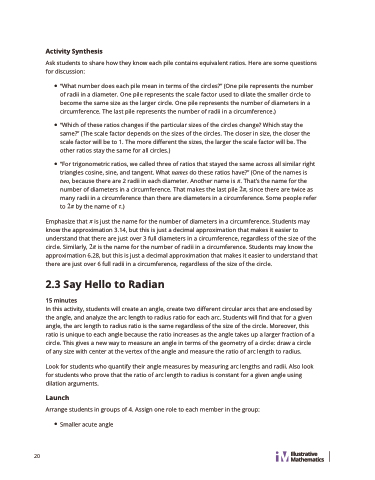Page 93 - IM_FL_Geometry_Print Sample
P. 93
Activity Synthesis
Ask students to share how they know each pile contains equivalent ratios. Here are some questions for discussion:
• “What number does each pile mean in terms of the circles?” (One pile represents the number of radii in a diameter. One pile represents the scale factor used to dilate the smaller circle to become the same size as the larger circle. One pile represents the number of diameters in a circumference. The last pile represents the number of radii in a circumference.)
• “Which of these ratios changes if the particular sizes of the circles change? Which stay the same?” (The scale factor depends on the sizes of the circles. The closer in size, the closer the scale factor will be to 1. The more di erent the sizes, the larger the scale factor will be. The other ratios stay the same for all circles.)
• “For trigonometric ratios, we called three of ratios that stayed the same across all similar right triangles cosine, sine, and tangent. What names do these ratios have?” (One of the names is two, because there are 2 radii in each diameter. Another name is . That’s the name for the number of diameters in a circumference. That makes the last pile , since there are twice as many radii in a circumference than there are diameters in a circumference. Some people refer to by the name of .)
Emphasize that is just the name for the number of diameters in a circumference. Students may know the approximation 3.14, but this is just a decimal approximation that makes it easier to understand that there are just over 3 full diameters in a circumference, regardless of the size of the circle. Similarly, is the name for the number of radii in a circumference. Students may know the approximation 6.28, but this is just a decimal approximation that makes it easier to understand that there are just over 6 full radii in a circumference, regardless of the size of the circle.
2.3 Say Hello to Radian
15 minutes
In this activity, students will create an angle, create two di erent circular arcs that are enclosed by the angle, and analyze the arc length to radius ratio for each arc. Students will nd that for a given angle, the arc length to radius ratio is the same regardless of the size of the circle. Moreover, this ratio is unique to each angle because the ratio increases as the angle takes up a larger fraction of a circle. This gives a new way to measure an angle in terms of the geometry of a circle: draw a circle of any size with center at the vertex of the angle and measure the ratio of arc length to radius.
Look for students who quantify their angle measures by measuring arc lengths and radii. Also look for students who prove that the ratio of arc length to radius is constant for a given angle using dilation arguments.
Launch
Arrange students in groups of 4. Assign one role to each member in the group: • Smaller acute angle
20
Teacher Guide


